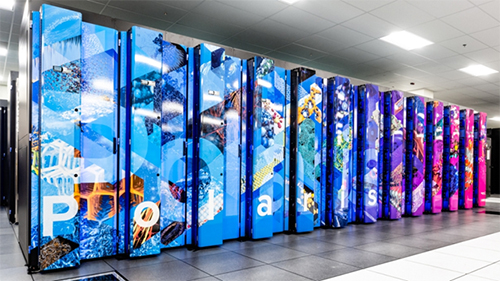 Polaris, the newest supercomputer at the U.S. Department of Energy’s (DOE) Argonne National Laboratory, is now open to the research community. Polaris will be a key tool to advance efforts to integrate Argonne Leadership Computing Facility (ALCF) computing resources more closely with DOE experimental facilities. Early projects will include coupling ALCF systems with the co-located Advanced Photon Source (APS) and Center for Nanoscale Materials (CNM), both DOE Office of Science user facilities at Argonne.
Polaris, the newest supercomputer at the U.S. Department of Energy’s (DOE) Argonne National Laboratory, is now open to the research community. Polaris will be a key tool to advance efforts to integrate Argonne Leadership Computing Facility (ALCF) computing resources more closely with DOE experimental facilities. Early projects will include coupling ALCF systems with the co-located Advanced Photon Source (APS) and Center for Nanoscale Materials (CNM), both DOE Office of Science user facilities at Argonne.
“Experimental facilities need powerful computing resources to keep pace with the increasingly large amounts of scientific data they are producing,” said ALCF Director Michael Papka. “By closely integrating ALCF supercomputers with the APS, CNM, and other experimental facilities, we can help speed data analysis and provide insights that allow researchers to steer their experiments in real time.”
The system, which is housed at the ALCF, also a DOE Office of Science user facility, provides a platform for researchers to prepare codes and workloads for Argonne’s upcoming Aurora exascale supercomputer. Polaris will also support several projects focused on using artificial intelligence (AI) for science and the integration of large-scale research instruments with high performance computing.
Built by Hewlett Packard Enterprise (HPE), Polaris is a 44-petaflops machine, meaning it can perform 44 quadrillion calculations per second.
“Polaris is around four times faster than our Theta supercomputer, making it Argonne’s most powerful computer to date,” said Papka. “The system brings advanced capabilities that will allow our user community to carry out simulation, data analysis, and AI tasks at a scale and speed that has not been possible with our previous systems.”
Like Aurora, Polaris is a hybrid system powered by both central processing units (CPUs) and graphics processing units (CPUs). This similarity, along with some other shared technologies, will help ease the transition to using Aurora for scientific research ahead of the exascale supercomputer’s deployment.
Polaris will immediately begin supporting several research teams getting ready for the arrival of Aurora via DOE’s Exascale Computing Project (ECP) and the ALCF’s Aurora Early Science Program (ESP).
“We have a very diverse set of projects lined up to use Polaris,” said Katherine Riley, ALCF Director of Science. “Some of the initial ECP and ESP research campaigns include using AI to accelerate cancer research, performing massive cosmological simulations to advance our understanding of the universe, and modeling turbulent flows to inform the design of more efficient aircraft.”
Now that Polaris is available, researchers can apply for computing time through the ALCF’s Director’s Discretionary allocation program.
The original ALCF story can be read here.
For details on the system, visit the Polaris user guide.
The Argonne Leadership Computing Facility provides supercomputing capabilities to the scientific and engineering community to advance fundamental discovery and understanding in a broad range of disciplines. Supported by the U.S. Department of Energy’s (DOE’s) Office of Science, Advanced Scientific Computing Research (ASCR) program, the ALCF is one of two DOE Leadership Computing Facilities in the nation dedicated to open science.
The Advanced Photon Source is a DOE Office of Science User Facility operated for the DOE Office of Science by Argonne National Laboratory under Contract No. DE-AC02-06CH11357
The U.S. Department of Energy's APS at Argonne National Laboratory is one of the world’s most productive x-ray light source facilities. Each year, the APS provides high-brightness x-ray beams to a diverse community of more than 5,000 researchers in materials science, chemistry, condensed matter physics, the life and environmental sciences, and applied research. Researchers using the APS produce over 2,000 publications each year detailing impactful discoveries, and solve more vital biological protein structures than users of any other x-ray light source research facility. APS x-rays are ideally suited for explorations of materials and biological structures; elemental distribution; chemical, magnetic, electronic states; and a wide range of technologically important engineering systems from batteries to fuel injector sprays, all of which are the foundations of our nation’s economic, technological, and physical well-being.
Argonne National Laboratory seeks solutions to pressing national problems in science and technology. The nation's first national laboratory, Argonne conducts leading-edge basic and applied scientific research in virtually every scientific discipline. Argonne researchers work closely with researchers from hundreds of companies, universities, and federal, state and municipal agencies to help them solve their specific problems, advance America's scientific leadership and prepare the nation for a better future. With employees from more than 60 nations, Argonne is managed by UChicago Argonne, LLC, for the U.S. DOE Office of Science.
The U.S. Department of Energy's Office of Science is the single largest supporter of basic research in the physical sciences in the United States and is working to address some of the most pressing challenges of our time. For more information, visit the Office of Science website.
